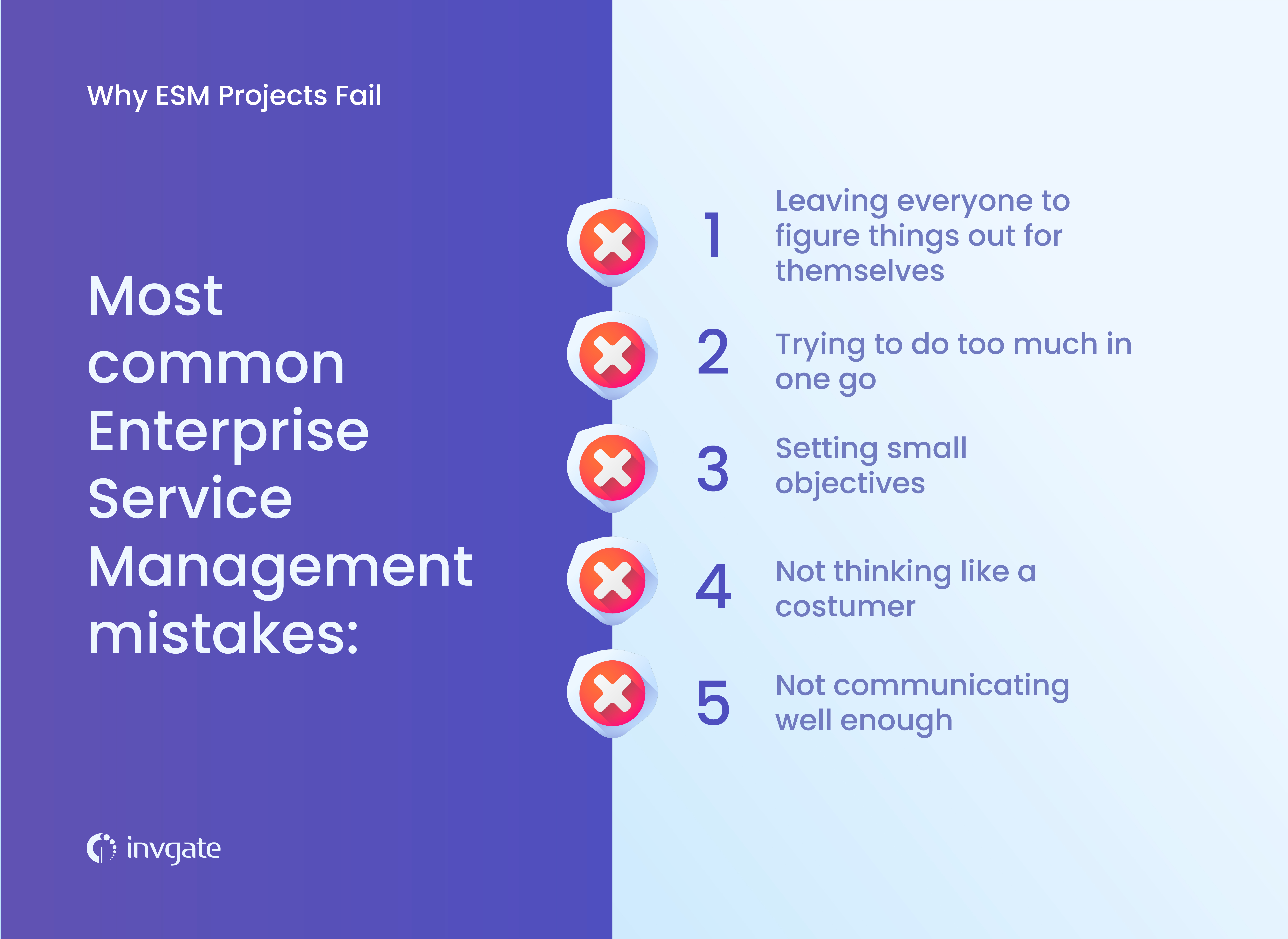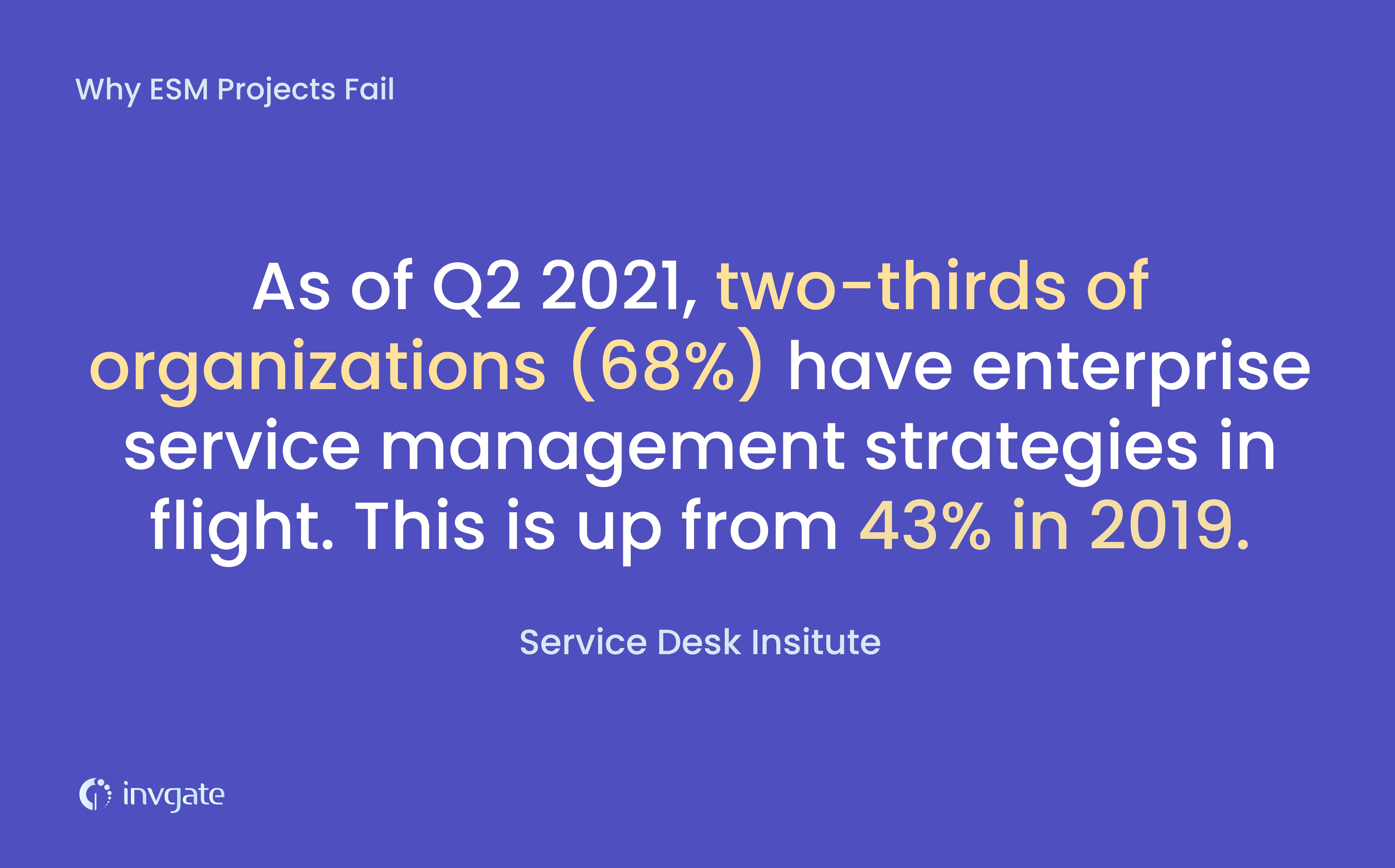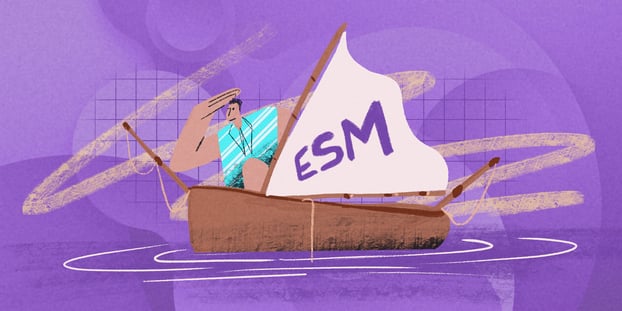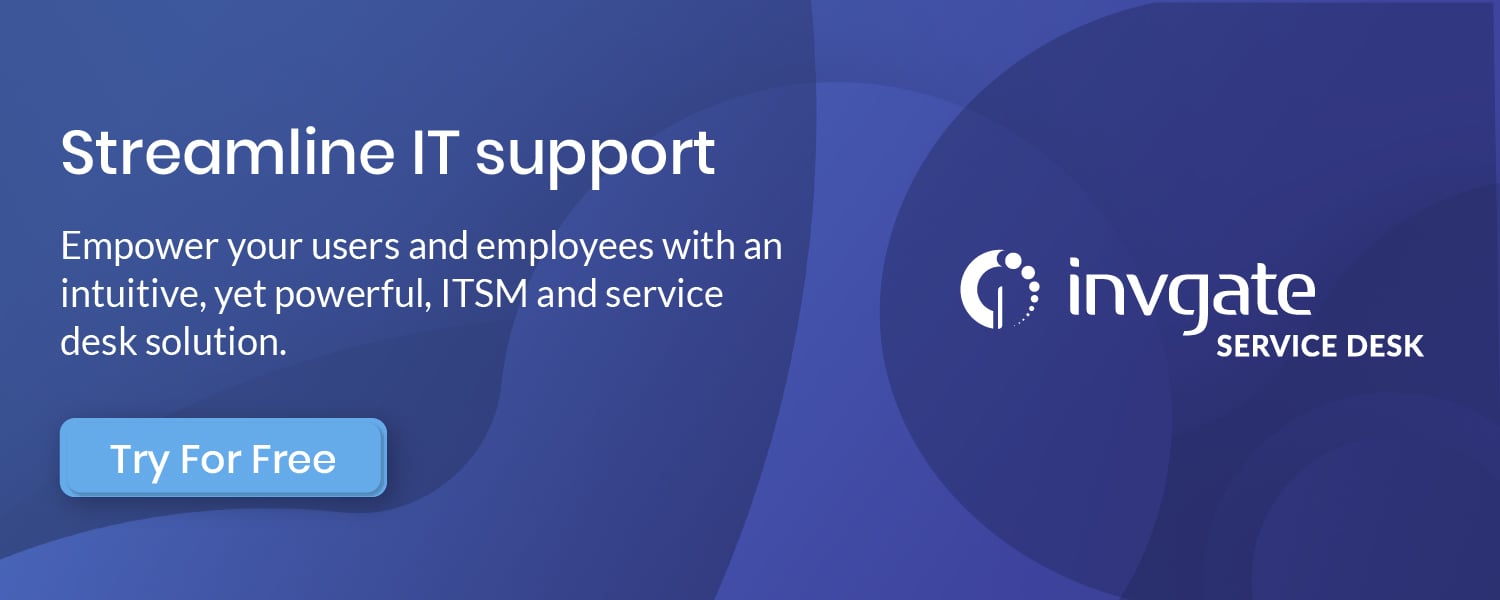When something works for a specific part of your company, it makes sense to look for ways to apply it to other sectors. Enterprise Service Management (ESM) is your go-to strategy when attempting to optimize, streamline, and generally improve service throughout your organization. It's the application of IT Service Management (ITSM) principles to other parts of your organization; a collection of best practices designed to help you liaise with departments and teams and help them achieve better results.
But, as is often the case, even the best-laid plans can end up in disaster. Sometimes it’s not just about getting the foundations right, but also about making sure you’re not making costly mistakes along the way. In this article, we’ll help you avoid the latter.
Of course, we’ve gone over enterprise service management several times in the past. If you feel a bit left out of the loop about the topic, we think that our definition from our article "What is Enterprise Service Management?" can be a handy refresher:
“Enterprise service management (ESM) is the extension of IT service management (ITSM) principles and capabilities to other areas of an organization. This will typically include not only using the same processes or practices used in ITSM, but also the same technology (for example, tools such as a Service Desk) as a means of work enablement.”
But enterprise service management works, fundamentally, when companies:
- Have a handle on the current and ongoing needs of their customers. Not what worked ten years ago.
- Find ways to add customer value from wherever it may come. That means your organization needs to be able to break free from its organizational silos when it counts.
Nail those, and you’re good. Don’t, and watch your projects get bogged down by endless bureaucratic and managerial issues.
FREE Enterprise Service Management CourseElevate customer satisfaction and optimize organizational performance. |
Proper communication from the IT team
One highly important point is the ability to properly communicate the concepts of service management to the rest of the company. Keep in mind that IT has a lot more experience than the rest of the company on how ticketing process flows work, so in order to successfully bring in other departments beyond IT, it's important to know how to explain it.
This topic is explored on the seventh episode of Ticket Volume, a podcast where InvGate Product Specialist Matt Beran speaks with IT leaders to explore their views on service management, technology, and business. In episode six, Matt speaks with ITSM consultant Kevin Clark.
On this topic, Kevin says:
IT, and the ITIL world, we've been doing this stuff for a long time. We've got really good ideas about how ticket flows work, how processes work, how categorization could work, and things like that. One thing I find very interesting when you talk to other parts of the business, they have a vague idea of how some of this stuff works, but they're not nearly as progressed as IT is. IT has learned this language, speaks it internally, understands the concepts, but maybe struggles to explain that to other parts of the business or other stakeholders who would benefit from a lot of those practices. I think that's a very important thing for us as service management professionals to start to understand.
Kevin Clark has 15 years of experience in IT service. He's a self-described passionate advocate for excellence and quality in Service Management, with a particular interest in the machinery behind good service. He's currently a Senior Consultant, and he's worked with brands such as ServiceNow and HP.
You can play the full episode above to learn more. You can also find Ticket Volume on all podcast platforms
Why do Enterprise Service Management (ESM) projects fail?
When things go wrong in ESM, it's usually due to some clearly identifiable enterprise service management mistakes. And even if you’ve started things off on the right foot, these can still sink your ship faster than an iceberg.
Let’s take a look at some of them below.

1. Leaving everyone to figure things out for themselves
Rookie mistakes, despite good intentions, can lead to a sub-optimal implementation, or a pile-up of issues that drag your organizational processes down.
And yes, we know It’s good to encourage people to try things out on their own, but not at the expense of efficiency. So, how do you fix this? By having your Enterprise Service Management tool vendor install your new software for you. And if they can help give you a set of guidelines and recommendations, as well as proper support once they’re done with the implementation, all the better.
So, when evaluating what ITSM platform or service desk to implement, always make sure that they’re not a “one-and-done” type of company. Rather, continuous support — as well as a keen understanding of your team’s own limitations — are absolutely basic.
Doug Tedder, principal at Tedder Consulting, said:
"Make sure you ask about implementation assistance if your team lacks expertise.”
2. Trying to do too much in one go
We’ve all done it, but when it comes to enterprise service management, cramming too much into a single project can lead to a bloated, confusing mess that simply doesn’t get anywhere.
And while it can be very tempting to tackle an end-to-end process in an ESM project, it can also be an extremely daunting — or downright impossible — task unless we’re talking about a very simple change management process.
The first part of this mistake is attempting to create a process flow at too high a level. In a process map that’s too general, with missing details, it’s hard to identify problem areas and mistakes.
The second part is the opposite, attempting to create an ultra-detailed value-stream map with every possible change management outcome accounted for. If you’re dealing with a complex process that involves many teams and departments, this can become a never-ending story of constant add-ons, revisions, and last-minute rollbacks.
So, how to solve this? When it comes to change management, the implementation of any new process, set tight, realistic guidelines. Choose something that you think your teams can manage in a period of 30 to 90 days. It may be necessary to create smaller splinter projects, and that’s OK. What you don’t want is for the process to get so long that it takes forever to finish, which causes teams to inevitably lose focus and things to become too drawn-out.
3. Setting small objectives
Service management done right can do a lot for your organization. But something that can easily slip through the cracks is the importance of not making your vision too narrow in scope. As a result, you can fall short of the nearly limitless potential that enterprise service management represents. It’s all about the possibility for a radical, digital-first transformation of your business practices, both in the back and front offices.
So, don’t set your sights too small. Enterprise service management can help you deliver better, faster, more accessible, higher-quality goods and services to your clients. You don’t want to be left in the dust when other companies or organizations leverage these opportunities to achieve fruitful innovations.
The possibilities for innovation are endless and don’t happen on their own if you cut yourself short. You have to give them the proper idea space to appear and to flourish. Otherwise, you’ll never even crack the surface of what ESM has to offer.
4. Not thinking like a customer
As we said at the beginning of the article, it’s not just about knowing what your customers needed yesterday; you have to stay connected with their wants, needs, and pain points at the present moment. Otherwise, the whole business model behind your organization can become stagnant, causing you to lose a percentage of your market share to competitors who are not afraid to keep their finger on the pulse.
But, the issue is even deeper than that. If you don’t stay ahead of your customers’ wants and needs, you lose seeing new profitable opportunities and possible roads towards expansion even as they pass right in front of your nose and wave goodbye.
You need to always keep your customers’ needs present, especially as they evolve and change. Always ask yourself “Who is my client?” and “What is important to them?” If you do it correctly, then you’ll always have an idea of their desired outcomes, what they expect from their interaction with you.
And this doesn’t apply just to your customers. Service delivery cuts both ways, towards customers and employees. The whole gamut of your business process needs to be covered by a proper use of ESM, from your service desk to your knowledge base.
Still, this doesn’t mean your company shouldn’t be customer-centric, quite the contrary. As companies like Amazon have proven time and time again, being customer-centric is what drives innovation and what makes customer service, and service itself, as painless and, dare we say, fun for all parties involved.
To do so, Tedder says to always start with a clearly defined business problem, and then to “Imagine how a combination of technology and process and services all might come to bear to solve the issue.”
5. Not communicating well enough
This is another part where businesses and leaders can do a sub-standard job. If there’s anything us humans have to learn to do better, it’s to communicate. And the thing about communication is that it’s not an open-and-shut thing; it’s an active process.
How many times have you and your employees attended a change management meeting, talked in-depth about an enterprise service management initiative, only to have the subject never be brought up again? And the blame falls strictly on the ESM process owners, who need to involve those concerned with the ongoing digital changes.
And this means letting everyone — from the stakeholders to the employees — know how the process is coming along, and to clear up any questions. Including every voice, letting them know they matter and are not pawns in a game is not just about humanizing your managers, it’s business function 101.
And speaking of managers, they shouldn’t be the only ones to participate. An all-too-common mistake is to think that these decisions only involve the higher-ups, and that’s a no-no. The reason why is because managers are typically not involved with the hands-on parts of many business processes. Plus, the day only has so many hours, and they have to delegate and receive second-hand updates and progress reports.
The solution is to involve the people on the floor in every part of the ESM process. That way, you’ll have access to the real way that things are being done, rather than managers relying on some document, report, or outline that details best-case scenarios that are rarely correlated with how things happen in the real world.
You know, it’s the typical scenario of “Oh, yeah, Pipe 1’s been a bit sketchy for a few months, so we reroute 22% of the flow through Pipe 2 at certain times of the day. If we don’t, Pipe 1 overheats. Still, we’re well within the expected throughput numbers” All the while, your managers may not evey know what in the world your floor workers are even yapping about.
So don’t assume, listen to everyone, include as many stakeholders from every part of the process as you can, and keep everyone apprised of every part of the process, from top to bottom and back.

Finding the way forward
Enterprise service management and ITSM can lead to more open communication, better-set goals, gaining more knowledge about your customer base, and promoting innovation. Here, Doug Tedder weighs in again:
“For ESM to be successful, the organization’s mindset must shift with regards to service management. Service management must become an organizational capability and competency, not just the domain of a single department or team within the organization.”
He also says that service management must be implemented beyond “mere” ITSM definitions.
“Many organizations that have implemented ITSM only addressed the operational aspects of service management. These organizations did not address nor take a holistic view of how services are designed, developed, delivered, and supported; they only addressed IT operations or just the service desk with their ITSM implementation. Application and software development, security, quality assurance, and the other aspects of service management were (or are still being) ignored or managed in separate, siloed approaches”
In the end, the focus should be on transparency, communication, and utilizing these principles broadly across your organization.
In closing
Enterprise service management, as we’ve explained, goes beyond ITSM and the service desk. It’s a way to make your whole business process more transparent, clearer, and able to involve all of your workforce, both for managing change and for opening up possible paths for innovation.
The rest is all about having the right ITSM tool, and the right service provider at your side to ensure that ESM is used the way it should be, with clear, actionable processes and results.

















